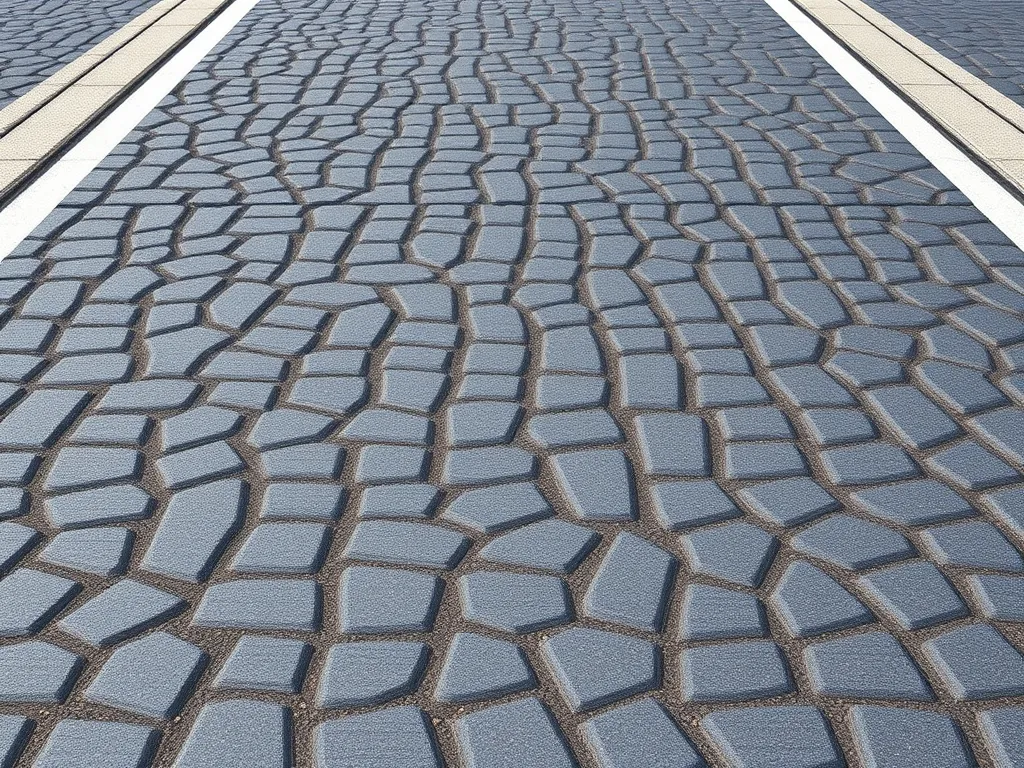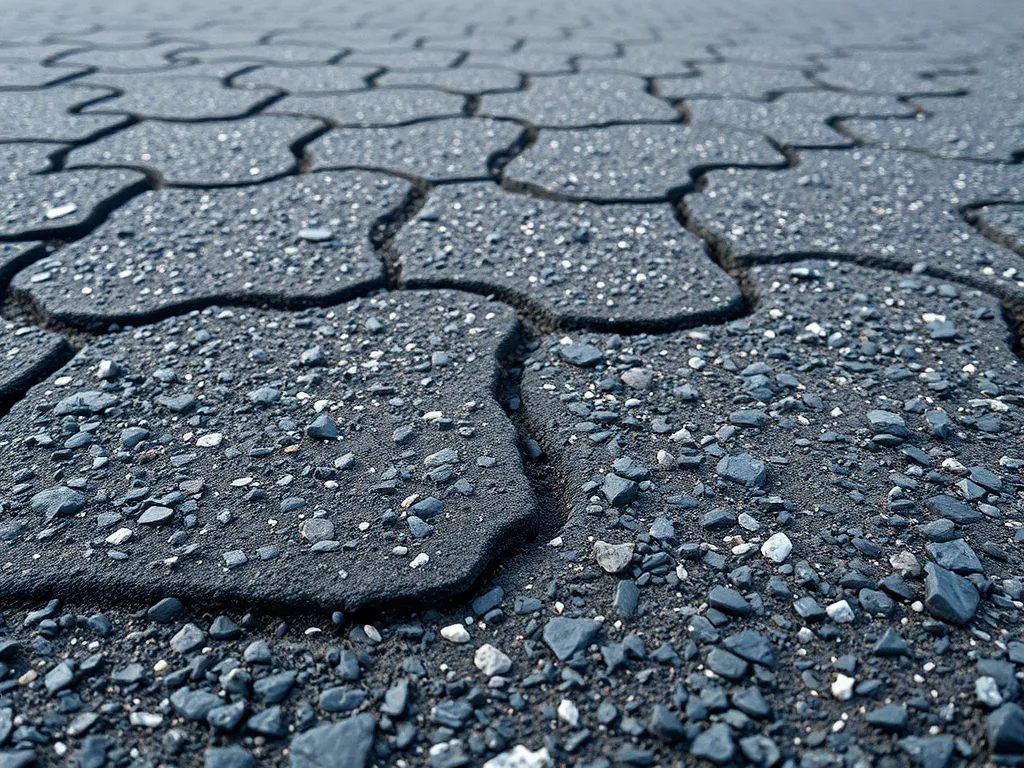Asphalt Vs Concrete: Which Pavement Quiets Traffic Noise Better?
Published on: October 28, 2025 | Last Updated: April 14, 2025
Written By: George Voss
Comparative noise studies analyze how asphalt and concrete surfaces affect road noise levels, focusing on factors like material composition, texture, and aging. Research shows asphalt typically produces 3-5 decibels (dB) less noise than concrete at highway speeds due to its porous structure and flexible surface. These differences matter in urban planning – a 3 dB reduction cuts traffic noise impact by half to human ears.
This article breaks down how each pavement type generates noise, compares real-world decibel data, and explores asphalt’s sound-reducing features. You’ll learn about surface porosity, rubber-modified mixes, and measurement methods like Close-Proximity (CPX) testing. We’ll also examine maintenance strategies that keep asphalt quiet over time and how cities use this data to fight noise pollution.
Contents
- Introduction to Pavement Noise Studies
- Noise Generation in Asphalt Vs Concrete Pavements
- Comparative Analysis Of Asphalt Vs Concrete Noise Levels
- Asphalt Pavement Characteristics Influencing Noise
- Quiet Pavement Technologies for Asphalt
- Methodologies in Asphalt-concrete Noise Comparison Studies
- Environmental Considerations in Pavement Noise
- FAQ: Asphalt Vs Concrete Noise Studies
- Final Thoughts
- Useful References for You:
Introduction to Pavement Noise Studies
Pavement noise studies test how roads make sound. These tests compare asphalt and concrete. They help cities pick roads that keep noise low. Less noise means better life for people near traffic.
Importance Of Noise Reduction in Urban Infrastructure
City noise harms health and daily life. Loud roads disrupt sleep and boost stress. Quiet streets help schools, homes, and hospitals. Rules now push for roads that cut noise by 50% in some zones.
Focus on Asphalt’s Role in Acoustic Performance
Asphalt can be built to soak up sound. Its surface has tiny holes that trap noise waves. Tests show fresh asphalt cuts 3-5 dB vs concrete. New mixes like porous asphalt drop noise more over time.
Next, we break down how asphalt and concrete make noise in different ways.
Noise Generation in Asphalt Vs Concrete Pavements
Pavement noise stems from tire-pavement interaction, influenced by surface properties. The composition of materials plays critical roles in sound generation.
How Asphalt Pavements Generate Noise
Asphalt surfaces produce noise through three primary mechanisms: tire vibration, air pumping, and tread impacts. The viscoelastic nature of bitumen-bound mixtures dampens vibrations, while open-graded textures reduce air compression. Studies show noise frequencies from asphalt typically range between 1000-2000 Hz, influenced by surface macrotexture depth (0.5-1.5 mm).
How Concrete Pavements Generate Noise
Concrete generates higher-pitched noise due to its rigid structure. Transverse tining or diamond grinding creates rhythmic texture patterns, causing consistent tire slap. Joints between slabs produce sharp “thump” sounds at 3-6 dB higher than adjacent surfaces. Noise frequencies often exceed 2500 Hz, linked to shorter texture wavelengths (10-30 mm spacing).
Key Differences in Noise Production Mechanisms
Four factors drive divergence in noise profiles:
| Factor | Asphalt | Concrete |
|---|---|---|
| Porosity | 12-25% voids reduce air pumping | Non-porous surfaces amplify compression |
| Surface Texture | Random aggregate orientation scatters sound | Uniform patterns create tonal peaks |
| Material Response | Flexible surface absorbs impact energy | Rigid structure reflects sound waves |
Field tests reveal concrete pavements emit 3-5 dB more noise than dense-graded asphalt. Rubber-modified mixes further narrow this gap by 1.8 dB.
Up next: Quantified decibel differences between materials in varied traffic conditions.

Comparative Analysis Of Asphalt Vs Concrete Noise Levels
Road surfacing choices directly impact traffic noise pollution. This analysis breaks down how asphalt and concrete perform in sound studies, using data from field trials and lab tests.
Decibel Measurements in Asphalt Noise Studies
Asphalt pavements typically show 3-5 dB(A) lower noise than concrete in controlled tests. A 2021 FHWA report found open-graded asphalt mixes register 96 dB(A) at 60 mph, vs 101 dB(A) for standard concrete. Rubber-modified asphalt cuts levels further—up to 7 dB(A) reduction—by dampening tire vibrations. Key studies like NCHRP Project 01-48 quantify this using Close-Proximity (CPX) methods.
Concrete Pavement Noise Levels in Comparative Studies
Concrete slabs generate higher-pitched sounds due to rigid surfaces and joint gaps. Transverse tining—a common texture for skid resistance—adds 2-4 dB(A) vs asphalt’s smoother finish. AASHTO TP 98-15 standards reveal concrete pavements average 99-103 dB(A) at highway speeds. Diamond grinding can lower this by 3 dB(A), but costs 30% more than asphalt milling.
Factors Affecting Asphalt’s Acoustic Performance
Three traits drive asphalt’s noise advantage: surface porosity, binder flexibility, and mix gradation. Porous asphalt with 18-22% air voids absorbs sound waves, cutting noise by 50% vs dense-graded mixes. Polymer-modified PG 76-22 binders maintain crack resistance while reducing brittleness that amplifies tire slap. Over time, clogging from dirt may diminish porosity, raising noise 1-2 dB(A) annually without cleaning.
Up next: How asphalt’s physical traits—from texture to aging—shape its long-term noise control capabilities.
Also See: Community Resources for DIY Driveway Repair Workshops
Asphalt Pavement Characteristics Influencing Noise
Surface design and material composition shape asphalt’s acoustic performance. Three factors dominate noise outcomes: texture, porosity, and aging patterns. These elements determine how asphalt stacks up against concrete in comparative noise studies.
Surface Texture and Noise Reduction in Asphalt
Asphalt’s surface texture directly impacts tire-pavement noise. Fine-graded mixes with smooth finishes lower high-frequency sounds by 2-4 decibels compared to coarse concrete. Diamond grinding or stone-matrix asphalt (SMA) creates micro-textures that disrupt sound waves. A 2020 asphalt concrete noise study showed SMA surfaces reduced pass-by noise by 3 dB(A) at 50 mph speeds.
Porosity and Sound Absorption Properties Of Asphalt
Open-graded friction course (OGFC) mixes contain 15-20% air voids, acting as noise traps. Sound waves enter pores instead of reflecting off surfaces. This porosity cuts tire whine by 5-7 dB versus dense-graded asphalt. Rubberized asphalt takes this further—crumb rubber additives absorb vibrations, lowering noise another 1-2 dB. Field tests in noise studies asphalt vs concrete reveal porous asphalt reduces highway noise 30% more than jointed concrete.
Aging Effects on Asphalt Noise Levels
Oxidized binder stiffens asphalt over time, raising noise levels 1-2 dB every 5-7 years. Raveling and cracks worsen acoustics by creating irregular surfaces. Regular maintenance like fog seals restores 80-90% of original noise reduction capacity. Long-term asphalt concrete noise studies show properly maintained surfaces retain noise advantages over concrete for 12-15 years before needing resurfacing.
While material properties set the baseline, advanced quiet pavement technologies push boundaries further. Next, we explore engineered solutions that enhance asphalt’s natural noise-reducing traits.

Quiet Pavement Technologies for Asphalt
Innovations in asphalt mix designs target noise reduction without sacrificing structural integrity. These solutions address tire-pavement interaction, the primary source of highway noise above 30 mph.
Open-graded Asphalt Mixes for Noise Reduction
Open-graded friction courses (OGFC) contain 15-25% air voids due to large aggregate gaps. This porous structure traps sound waves from tire treads, cutting noise by 3-7 decibels compared to dense-graded asphalt. A 2022 NAPA study found OGFC roads register 96 dB at 60 mph, versus 103 dB for traditional mixes. Drainage benefits also reduce hydroplaning risks.
Rubberized Asphalt and Sound Dampening
Rubber-modified asphalt mixes blend 15-22% recycled tire crumb with bitumen. This rubber matrix absorbs vibrational energy from vehicle loads, lowering high-frequency noise by up to 50%. Field tests by FHWA show rubberized surfaces reduce traffic noise 4 dB more than standard asphalt. Each lane-mile recycles 500-2,000 scrap tires, aligning noise control with sustainability goals.
Maintenance Practices to Sustain Low Noise Levels
Routine upkeep prevents surface degradation that increases noise. Annual crack sealing limits water intrusion causing raveling. Fog seals applied every 3-5 years restore surface flexibility, preserving air void structure. Diamond grinding removes ruts while maintaining 1.5-3.0 mm texture depth, a key factor in noise generation. Proper care keeps asphalt 2-5 dB quieter than concrete over 15-year life cycles.
Testing protocols for these technologies shape ongoing asphalt-concrete noise comparisons. Next, we analyze how researchers measure acoustic performance across pavement types.
Methodologies in Asphalt-concrete Noise Comparison Studies
Scientists employ precise methods to measure how different pavements affect sound levels. These techniques help quantify differences between materials under varied conditions.
On-site Noise Measurement Techniques for Asphalt
Field studies use sound level meters placed 25-50 feet from traffic lanes. The ISO 11819-1 standard guides pass-by tests with vehicles moving at 30-50 mph. Key factors tracked:
- Traffic speed (35-70 mph impacts noise by 3-5 dB per 10 mph)
- Surface texture depth (0.5-1.5 mm optimal for noise reduction)
- Microphone height (4 feet above ground minimizes reflections)
Portable systems like the Statistical Pass-By method capture real-world data across 200+ vehicle events. This method eliminates bias from single-source measurements in noise studies asphalt vs concrete.
Laboratory Testing Of Asphalt Pavement Acoustics
Controlled settings use impedance tubes to test sound absorption coefficients. Samples with 15-25% air voids show 3-7 dB reductions versus dense-graded mixes. Rolling tire machines simulate tire-pavement contact at 60 mph, measuring frequencies between 800-2000 Hz where human hearing is most sensitive.
Lab tests follow ASTM E1050 standards but face limitations. They can’t replicate weather wear or traffic polishing seen in long-term asphalt concrete noise studies.
Analyzing Tire-pavement Interaction Noise
Over 70% of traffic noise stems from tire-pavement contact. Two mechanisms dominate:
- Impact noise: Caused by tread blocks striking surface texture (common on rigid concrete)
- Air pumping: Occurs when tires compress air in pavement voids (mitigated by porous asphalt)
Laser profilometers scan texture wavelengths. Surfaces with sub-20 mm spacing cut high-frequency noise by up to 50% compared to concrete’s 40-60 mm grooves.
These methods shape our grasp of how pavement choices influence soundscapes near roads. Next, we explore how these findings tie into broader ecological impacts.

Environmental Considerations in Pavement Noise
Noise pollution from roadways impacts ecosystems, human health, and urban livability. Studies comparing pavement types focus not just on decibel levels but broader ecological consequences tied to material choices.
Asphalt’s Role in Reducing Traffic Noise Pollution
Porous mixes with rubberized components cut tire-pavement noise by up to 7 decibels versus dense-graded surfaces. This reduction equates to doubling the distance between source and listener. Quieter roads lower the need for sound walls, which require steel production emitting 1.85 tons of CO₂ per ton made. Open-graded friction courses (OGFC) further reduce hydroplaning risks while dampening high-frequency noise above 1000 Hz.
Long-term Environmental Impact Of Quieter Asphalt Pavements
Over 20 years, recycled rubber-modified surfaces maintain 85% of initial noise reduction properties. Life-cycle studies show quieter pavements lower vehicle fuel use by 3-4% due to smoother textures reducing rolling resistance. With 90% recyclability rates, reclaimed asphalt pavement (RAP) in new mixes prevents 60 million tons of waste yearly in the U.S. alone. Reduced reliance on noise barriers also minimizes mining for raw materials like limestone or steel.
These ecological benefits make quiet asphalt pavements vital for cities targeting ISO 37120 sustainability standards. Next, we explore common questions about pavement noise performance.
FAQ: Asphalt Vs Concrete Noise Studies
Does Asphalt Reduce Noise Compared to Concrete?
Yes, studies show that asphalt reduces noise levels compared to concrete, generally producing 3-5 decibels (dB) less noise at highway speeds. This reduction can significantly impact urban noise pollution and overall quality of life for residents near busy roadways.
Is Asphalt Pavement Quieter Than Concrete?
Overall, asphalt pavement tends to be quieter than concrete pavement. The porous nature of asphalt and its ability to absorb sound waves contribute to this difference. Research indicates that at highway speeds, asphalt surfaces are consistently quieter, making them a preferable option in noise-sensitive areas.
Is Concrete More Environmentally Friendly Than Asphalt?
While concrete is often viewed as durable and low-maintenance, it is not necessarily more environmentally friendly than asphalt. Asphalt has a higher recyclability rate and quieter pavements can help reduce overall noise pollution, potentially improving urban ecosystem health. The choice between the two often depends on specific project goals, including sustainability and noise reduction.
Final Thoughts
Comparative noise studies reveal significant insights into the acoustic performance of asphalt and concrete pavements. Asphalt generally demonstrates superior noise reduction capabilities, making it a favorable option for urban environments where noise control is vital. Characteristics such as surface texture, porosity, and innovative technologies like open-graded asphalt mixes enhance its sound-absorbing properties.
Moreover, these studies show that asphalt pavements, alongside proper maintenance, can maintain lower noise levels over time. This not only contributes to a quieter environment but also reduces traffic noise pollution, offering long-term environmental benefits.
For those interested in detailed information about pavement noise and its implications, visit Asphalt Calculator USA.
Useful References for You:
- Huang, Y. H. (2004). Pavement Analysis and Design (2nd ed.). Upper Saddle River, NJ: Pearson/Prentice Hall.
- Utilization of porous asphalt material in road construction for reducing the vehicular noise – ScienceDirect
- Noise-reducing pavements get loud acclaim in US and Europe: understanding the issue – Asphalt magazine


